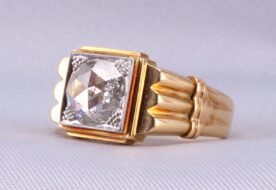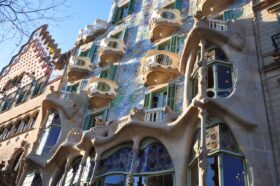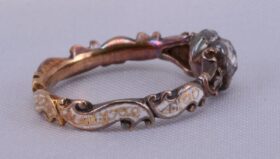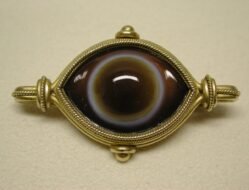
16 May Antique Micromosaic Jewelry: Sell a Brooch or Pendant
Seen Above: An antique micromosaic gold bracelet with scene of Italian peasant girls
Antique micromosaic jewelry is one of those rare art forms where history, craftsmanship, and beauty come together in a captivating way. At C. Blackburn Jewelers we always are excited when someone visits us looking to sell a micromosaic brooch or pendant, as these pieces are literally works of art in the form of fine jewelry.
Originating in 18th- and 19th-century Italy, micromosaic jewelry is made from tiny, colorful glass tiles called tesserae, arranged with extraordinary precision to form detailed scenes and stunning designs. Whether it’s a delicate pendant or an ornate brooch, each piece tells a story—not just of the subject it portrays, but of the era and hands that brought it to life.
Very few San Diego estate jewelry are experienced in evaluating the fine micromosaic jewelry because the best pieces are so rare. However, our owner Carl Blackburn is a 2nd generation estate jeweler who understands the craftsmanship involved and which items hold the most value on the estate jewelry market.
You can be assured of selling your antique micromasaic pendant or brooch for the best price by visiting our La Jolla jewelry store. It all starts with the free market appraisal. Set up an appointment by calling 858-251-3006 or send us a text message at 619-723-8589. If you can’t visit us in person, click the following link to learn how you can sell us your item via secure shipping: Sell Jewelry Online.
A Glimpse into the Past
The story of micromosaics actually begins much earlier than the 18th century. The technique has its roots in ancient Roman mosaics, those grand floor and wall artworks created from stone, glass, and ceramic. Fast-forward to the Renaissance, and interest shifted toward smaller, more intricate expressions of this art, paving the way for the delicate micromosaics we admire today.
Italy—especially Rome and Florence—became the epicenter for this artistic evolution. During the Grand Tour era, when young aristocrats traveled Europe to absorb its culture, Italy stood out. Artisans responded to the influx of tourists by creating portable micromosaic souvenirs, often showcasing classical scenes, famous landmarks, or lush floral motifs. These tiny treasures became must-have collectibles.
By the 19th century, micromosaic jewelry had reached the height of its popularity. A major driver of this success was the Vatican Mosaic Studio in Rome, which perfected the creation of ultra-fine glass tesserae. Their innovations enabled artists to produce more detailed and vivid pieces, ranging from earrings to bracelets, that embodied the elegance of the time.
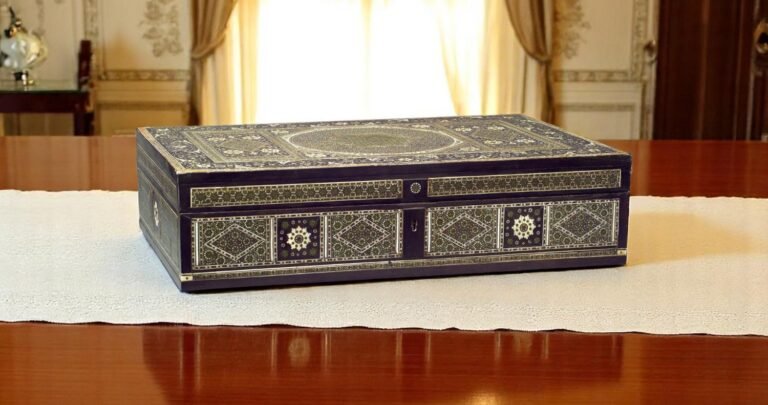
The Art of Crafting Micromosaic Jewelry
Creating micromosaic jewelry isn’t for the impatient. It begins with smalti, a special kind of opaque colored glass. This glass is heated, stretched into thin rods, and then cut into minuscule pieces—often less than a millimeter wide.
Next comes the painstaking process of assembling the mosaic. The artist starts with a carefully chosen base—metal, stone, or ceramic—and uses fine tweezers to place each tessera one by one, ensuring there are no gaps and that colors blend seamlessly to bring the design to life. Depending on complexity, this process can take hours or even days.
Once the image is complete, the adhesive must fully dry before the piece is polished, smoothing out any rough spots and adding a beautiful shine. The result is a miniature masterpiece—both jewelry and artwork in one.
Materials That Make the Magic
At the heart of every micromosaic is smalti. This colored glass, made by mixing silica, soda, and metal oxides, was prized for its vibrant hues and clarity. But the glass was only part of the equation.
Fine micromosaic jewelry was often set in gold or silver, lending a luxurious finish. Sometimes, designers added pearls, garnets, or turquoise for extra depth and contrast. As for the base, it might be metal for strength, stone like marble or slate for elegance, or even ceramic for a smooth, detail-friendly surface. Regardless of materials, craftsmanship always took center stage.
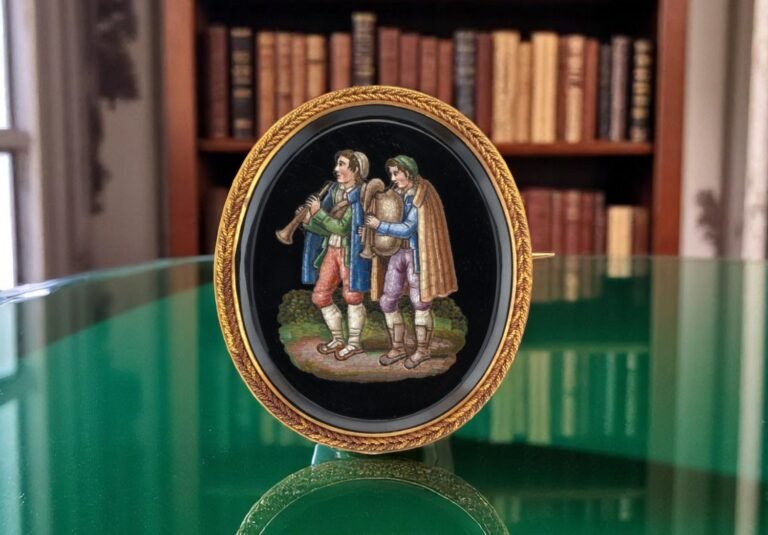
Notable Artists and Iconic Workshops
Some names stand out in the history of micromosaics. Giacomo Raffaelli, active in the late 18th and early 19th centuries, was a pioneer. Known for his precision and vibrant scenes, Raffaelli became a favorite of European aristocracy.
Then there was Luigi Cavaliere Moglia of the Vatican Mosaic Studio. His work, often depicting religious themes and iconic landmarks, reflected both technical mastery and artistic sensitivity. The Studio itself produced many exceptional pieces, some commissioned by the Church and royalty.
Also key to the story is the Castellani family of Rome. They blended micromosaic techniques with ancient Roman and Etruscan revival styles, preserving historic craftsmanship while pushing creative boundaries. Their pieces are still highly sought after today.
What Makes Micromosaics So Valuable?
Collectors love micromosaic jewelry for its artistry, rarity, and historical depth. Value can depend on several factors: the piece’s age, condition, provenance, and—of course—the artist behind it. Works by renowned names like Raffaelli or from the Vatican Studio are especially prized.
Detail is another big factor. The more intricate the design, the more skill and time it took to create—and the more valuable it tends to be. Condition matters too: pieces in excellent shape or with minimal restoration are worth more. Provenance, or ownership history, can also boost value, particularly if the piece was part of a notable collection or has documented origins.
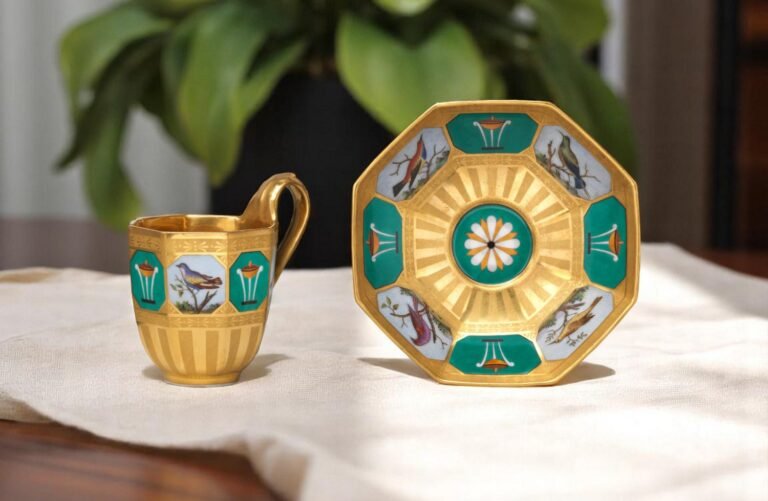
How to Spot the Real Deal
Recognizing authentic antique micromosaics takes a sharp eye. Genuine pieces from the 18th and 19th centuries typically feature extremely fine tesserae with tight, seamless placement. The color should still be vivid, and the image sharply defined.
High-quality settings—often in gold or silver—are another giveaway, especially when paired with traditional base materials like stone or ceramic. Modern reproductions might lack the precision and use cheaper components.
Pay attention to the design as well. Classical themes, landscapes, famous landmarks, and intricate floral motifs are hallmarks of genuine antique micromosaics. When in doubt, it’s wise to consult expert like C. Blackburn Jewelers or reference trusted sources before buying.
Caring for Your Micromosaic Jewelry
These pieces may fashioned in a gold or platinum setting, but they’re delicate and deserve careful handling. Keep them stored in a cool, dry environment, away from direct sunlight and humidity. Avoid stacking them or letting them rub against other jewelry—individual padded boxes or pouches work best.
For cleaning, a soft, dry brush is ideal for removing dust. A slightly damp cloth can be used on metal settings, but steer clear of harsh chemicals or abrasive materials. If your piece needs deeper cleaning or repair, seek a professional conservator with experience in antique jewelry.
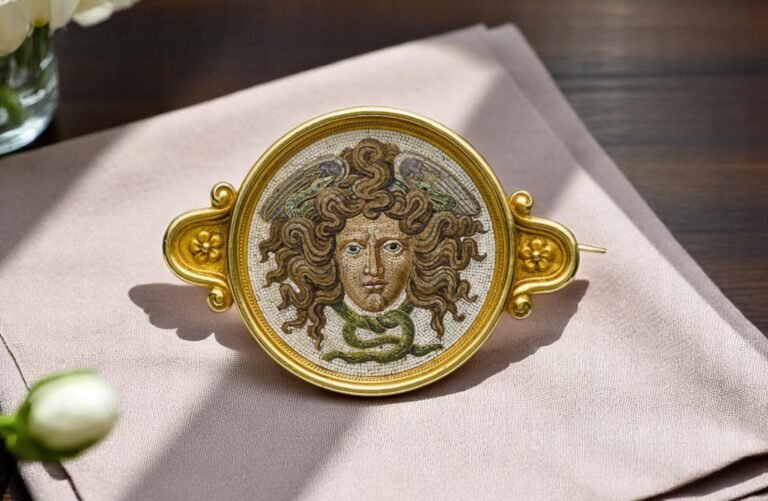
Buying and Selling Micromosaic Estate Jewelry
If you’re looking to buy or sell antique micromosaic jewelry, there are several options. Reputable auction houses like Sotheby’s and Christie’s often feature them in their sales, offering authenticated pieces with detailed provenance.
Antique jewelry dealers and galleries are another reliable source, especially those specializing in European jewelry. For online shoppers, platforms like 1stdibs and Ruby Lane connect buyers with vetted dealers around the world.
When selling antique micromosaic brooches or pendants in San Diego, C. Blackburn Jewelers is one of your best options. All sellers can meet personally with owner Carl Blackburn, who has been buying and selling micromosaic estate jewelry for over 30 years.
Tell Carl about the antique micromosaic jewelry you would like to sell by leaving him a voicemail at 858-251-3006 or send him a text message at 619-723-8589. You also can send him an email by using the contact form below.

